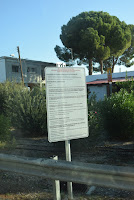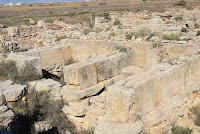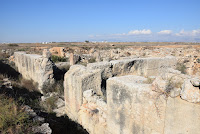In order to explore the Northern part of Cyprus we had to go through one of the five divided capital of Nicosia's crossing points beyond which Turks are in charge since the 1974 troop invasion. I was quite curious as to how easily or not we would be able to cross the borders, which thanks to our Cypriot Greek guide Androulla we went through without any visible problems.
I noticed the change in the landscape despite the fact that we soon found ourselves in the middle of the remains of a Bronze Age town, which archaelogists estimate to have been founded in the 18th century BC and have grown rich on trading in copper, which was excavated on the island and exported to Anatolia, Syria and Egypt.
Our attention was soon drawn to what Michel so exhultantly showed us about the former Mycenaean settlement.
Our attention was soon drawn to what Michel so exhultantly showed us about the former Mycenaean settlement.

Excavation works conducted since 1896 did unearth the ruins of the late Bronze Age settlement, with its low houses lining narrow streets. We stumbled upon several vestiges dating back to that epoch which abunded in the site. The ruins yielded a tablet with Cypriot-Minoan writing, not yet decyphered and a famous bronze statue of the Horned God, dating from the 12th century BC, which is now kept in the Nicosia Museum.
Strolling around the excavation site we came across the horned God's sanctuary and the "House of the Bronzes" where many bronze artefacts are said to have been found. We were shown details that we would have otherwise missed, had we not had such an enthusiastic guide.
Strolling around the excavation site we came across the horned God's sanctuary and the "House of the Bronzes" where many bronze artefacts are said to have been found. We were shown details that we would have otherwise missed, had we not had such an enthusiastic guide.










(To be continued)














No comments:
Post a Comment